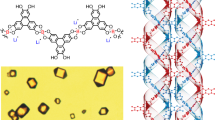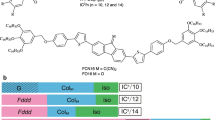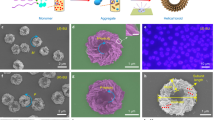Abstract
Attempts to generate films, wires, helices, rings and regular patterns out of inorganic materials1,2,3,4,5,6,7,8,9,10 have been going on for the past 100 years. We show here that stable helices of porous manganese oxide materials can be formed spontaneously from uniform sols and that they are excellent semiconductors. These inorganic helices contain micropores, can be converted into other structures, and their composition can be varied.
Similar content being viewed by others
Main
Tetramethyl ammonium (TMA+) permanganate salts in 2-butanol/H2O form sols that when heated in open capillary tubes can form ring and helical gels (Table 1 and Fig. 1). Helices are produced from concentrated sols and separated rings at low concentrations (10−3). The spacing between rings increases from the top to the bottom end of the capillary, as in the spacing law demonstrated by Liesegang rings11.
Different samples A–O represent colloids produced by varying manganese concentration, capillary diameter, temperature, and heating period (Table 1). The encapsulated self-assembled products are shown as the final morphology attained after solvent evaporation at 85 °C. Coin diameter is 18 mm.
When helices form, the number of turns per unit length is primarily related to the starting concentration of the sol, whereas their diameters are mainly influenced by the capillary diameter and range from millimetres to less than 30 µm, with lengths of up to 25 cm. Free-standing helices can be obtained by cutting the tubes, or by using water to detach them from the capillary wall.
The formation of helices starts first by virtue of a contraction of the sol–gel as a result of solvent evaporation. The elastic gel then buckles into a helical shape, possibly because of the capillary pressure applied at its upper end by the surrounding fluid. Further evaporation of solvent eliminates this capillary pressure and the gel expands from the bottom to the top of the capillary (see http://www.lib.uconn.edu/chemistry/SuibGroup/suibg.html). We are investigating the mechanism of this process by quantifying the contribution and interplay of gel anisotropy and elasticity, wetting and dewetting, capillarity, and agglomeration of the sol particles that combine to produce these remarkable shapes.
Ion exchange of the TMA helix with K+ leads to crystalline helices with composition K0.93+Mn2.14+Mn1.93+O7(OH)1.03·2.7H2O; the lattice parameters are similar to those of synthetic birnessite (OL-1; ref. 12). Ion exchange is rapid, indicating that these materials are highly permeable. Thermal treatment of the helices of K-OL-1 at 500 °C leads to the formation of an octahedral molecular-sieve (OMS) tunnel structure of synthetic cryptomelane (OMS-2), and a composition of K1.86+Mn4.74+Mn3.33+O14.57(OH)1.43·0.7H2O with an average oxidation state for manganese of 3.58.
We examined the K-OMS-2 helices by scanning and transmission electron microscopy. Striations are evident along the length, indicative of a fibrous structure, corroborated by the direction of crack propagation from sample preparation. The helix cores are usually solid, however, with secondary spiralling along the radial direction of the helix being sometimes seen. The helix cores are usually solid.
The microstructure leads to microporosity of the 2×2 crystal structure of OMS-2, mesoporosity in between the colloidal crystallites, and a net alignment and connectivity of the microporous network along the length of the helix. This alignment leads to conduction along the helix and, as a result of the porosity, rate processes such as ion exchange are enhanced owing to fast diffusion. The anisotropic (that is, larger by an order of magnitude in the direction parallel to the helix axis compared with the perpendicular direction) DC-4 probe conductivity of 4.2×10−1 W−1cm−1 at 21 °C for the K-OMS-2 system is roughly an order of magnitude more conductive than most well-formed single crystals of semiconducting cryptomelane-like materials12.
References
Wu, C. G. & Bein, T. Science 264, 1757–1759 (1994).
Trau, M. et al. Nature 390, 674–676 (1997).
den Exter, M. J. et al. in Recent Advances and New Horizons in Zeolite Science and Technology (ed. Chon, H.) Vol. 102, 413–454 (Stud. Surf. Sci. Catal., Elsevier, Amsterdam, 1996).
Jones, C. W., Tsuji, K. & Davis, M. E. Nature 393, 52–54 (1998).
Davis, W. B. et al. Nature 396, 60–63 (1998).
Rowan, A. E. & Nolte, R. J. M. Angew. Chem. Int. Ed. 37, 63–68 (1998).
Soghomonian, V. et al. Science 259, 1596–1599 (1993).
Gier, T. E., Bu, X., Feng, P. & Stucky, G. D. Nature 395, 154–157 (1998).
Raimondi, M. E., Maschmeyer, T., Templer, R. H. & Seddon, J. M. J. Chem. Soc. Chem. Comm. 19, 1843–1844 (1997).
Bruinsma, P. J. et al. Chem. Mater. 9, 2507–2512 (1997).
Antal, T., Droz, M., Magnin, J. & Racz, Z. Phys. Rev. Lett. 83, 2880–2883 (1999).
Shen, Y. F. et al. Science 260, 511–515 (1993).
Author information
Authors and Affiliations
Corresponding author
Rights and permissions
About this article
Cite this article
Giraldo, O., Brock, S., Marquez, M. et al. Spontaneous formation of inorganic helices. Nature 405, 38 (2000). https://doi.org/10.1038/35011139
Published:
Issue Date:
DOI: https://doi.org/10.1038/35011139
This article is cited by
-
Colloidal Manganese Oxide Precursor to Octahedral Layered, OL-3 Materials
Journal of Inorganic and Organometallic Polymers and Materials (2007)
Comments
By submitting a comment you agree to abide by our Terms and Community Guidelines. If you find something abusive or that does not comply with our terms or guidelines please flag it as inappropriate.




